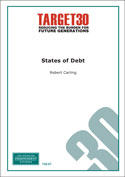States of Debt
Home » Publications » States of Debt

While Commonwealth government debt has been the focus of attention recently, this report takes a broader view by bringing state debt into the picture.
State debt, like that of the federal government, has also risen dramatically since 2007, when net debt was negative. In the six years to 2013, states added $70 billion to their general government net debt, to reach a positive level of $43 billion.
By 2016–17, combined Commonwealth and state general government (GG) net debt will exceed $350 billion—almost 20% of GDP, or more meaningfully, more than 50% of general government revenue.
For the broader non-financial public sector (which includes non-financial public corporations), state net debt was much higher at $127 billion in 2013. Combined with the Commonwealth, total non-financial public sector net debt was $283 billion, already 50% of the sector’s revenue.
At current levels aggregate state debt is manageable, but the upward trend is of concern. The above figures exclude non-debt financial liabilities such as unfunded superannuation and long-service leave liabilities, which loom large in state finances.
The states’ financial position has deteriorated because their net operating surpluses have shrunk while capital (‘infrastructure’) spending soared, resulting in large cash deficits.
All states have experienced this deterioration. They have curbed the growth of operating expenditure, but they will need to persevere in the face of sluggish revenue if they are to rebuild operating surpluses and avoid sharp cuts in capital expenditure.
Robert Carling is a Senior Fellow at The Centre for Independent Studies.
